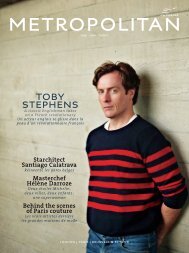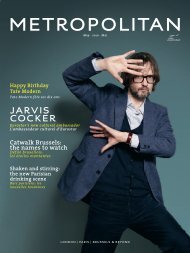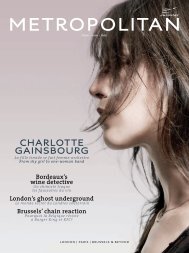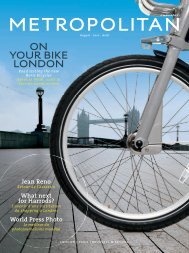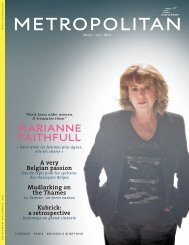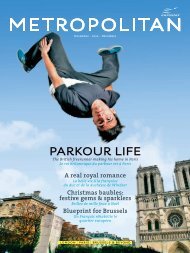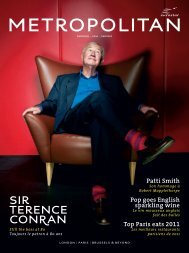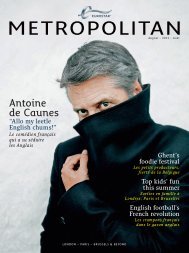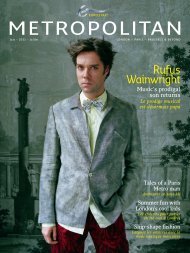september-2010
september-2010
september-2010
You also want an ePaper? Increase the reach of your titles
YUMPU automatically turns print PDFs into web optimized ePapers that Google loves.
scandal. May 29, 1912: Nijinksy simulates sex with a ribbon on<br />
the opening night of Debussy’s L’Après-midi d’un faune; May<br />
29, 1913: Stravinsky’s The Rite of Spring provokes a riot; May 11,<br />
1917: a red fl ag is unfurled during a performance, terrifying a<br />
French audience already alarmed by news from Russia of the<br />
February Revolution; May 18, 1917: Parade (set and costumes by<br />
Picasso, scenario by Cocteau, music by Eric Satie) introduced<br />
Cubism to ballet with a cacophony of strange costumes and<br />
a score that featured typewriters, gunshots and sirens.<br />
Later works such as 1923’s Les Noces and 1928’s Apollon<br />
Musagète were the company’s masterpieces – but they are<br />
not what the Ballet Russes is remembered for.<br />
Diaghilev had made his name exhibiting art in Russia (he<br />
was one of the fi rst to show the French Impressionists), but<br />
his fi rst love was music and in 1908 he was<br />
Above: front cloth<br />
for Le Train bleu,<br />
after Picasso.<br />
Opposite, from top:<br />
costume for Parade<br />
by Picasso; costume<br />
after Benois for<br />
Les Sylphides; The<br />
Firebird<br />
Ci-dessus : rideau<br />
pour Le Train bleu,<br />
d’après Picasso. À<br />
droite : costumes<br />
pour Parade de<br />
Picasso, pour Les<br />
Sylphides d’après<br />
Benois et pour<br />
L’Oiseau de feu<br />
102 METROPOLITAN<br />
asked to stage an opera in Paris. In those<br />
days opera often featured dancing in the<br />
interlude. Ballet was the lesser sibling, “a<br />
frivolous excuse for showing pretty girls<br />
and dresses”, as one critic put it, but<br />
Diaghilev sensed its potential. “The artists<br />
he worked with, Alexandre Benois and Leon<br />
Bakst, were interested in the ballet, and<br />
through them he saw that ballet was as<br />
ready for reform as opera had been before<br />
Wagner,” says Pritchard. “He saw he could<br />
make a mark.”<br />
But to do this he needed a star, and he<br />
found one in Nijinsky. “Nijinksy had real<br />
virtuosity. There was a lightness to his leaps<br />
that made him look as if he could hover in the air,” says<br />
Pritchard. “Male dancing had gone out of fashion and people<br />
hadn’t seen this for a long time. He also had a very<br />
charismatic stage presence and could be very different in<br />
each role.”<br />
Nijinksy was under contract with Russia’s Imperial Ballet.<br />
It has never been established whether Diaghilev, who was<br />
having an affair with the dancer, was responsible for what<br />
happened next, but it certainly worked to his advantage.<br />
Nijinksy appeared on stage in Russia wearing a costume shorn<br />
of the usual “modesty trunks”, thus deemed dangerously<br />
revealing. He was dismissed in disgrace. Diaghilev took full<br />
advantage. A telegram to his French backers shows his<br />
modus operandi: “Appalling scandal. Use publicity.”<br />
This was a pattern that was repeated throughout the<br />
Ballets Russes’s early days. Stravinsky’s The Firebird, with<br />
choreography by Michel Fokine and sumptuous designs by<br />
Bakst, had been a success in 1910 and Diaghilev, Stravinsky<br />
and Nijinsky were hungry for more. While Stravinsky, who<br />
had been discovered by Diaghilev, worked on his next ballet,<br />
Nijinsky prepared his debut choreography to Debussy’s<br />
L’Après-midi d’un faune at the Chatelet. A short piece that<br />
featured eight dancers – Nijinksy and seven nymphs – this<br />
ended with Nijinksy jerking his pelvis over a piece of cloth<br />
dropped by a nymph. The audience was appalled.<br />
“Sexual simulation on stage wasn’t something people<br />
expected to see at the time,” deadpans Pritchard. “He toned<br />
it down after that, but they’d already got a lot of publicity.”<br />
The following year’s controversy was even greater, when<br />
the Art Deco Théâtre des Champs-Élysées became the setting<br />
Photograph: © Getty



